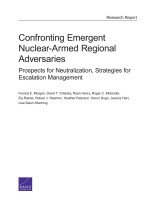| 来源类型 | Research Reports
|
| 规范类型 | 报告
|
| ISBN | 9780833089090
|
| 来源ID | RR-974-AF
|
| Confronting Emergent Nuclear-Armed Regional Adversaries: Prospects for Neutralization, Strategies for Escalation Management |
| Forrest E. Morgan; David T. Orletsky; Ryan Henry; Roger C. Molander; Ely Ratner; Robert Reardon; Heather Peterson; Harun Dogo; Jessica Hart; Lisa Saum-Manning
|
| 发表日期 | 2015
|
| 出版年 | 2015
|
| 页码 | 124
|
| 语种 | 英语
|
| 结论 |
Dilemmas for U.S. Decisionmakers- In a crisis involving the United States and a nuclear-armed regional adversary, the United States would need to try to (1) avoid driving the adversary across its nuclear threshold, (2) reassure vulnerable partners, (3) persuade other powerful actors to exercise restraint, (4) deter further nuclear use if the adversary crosses the nuclear threshold in some way, and (5) decide whether to attempt to neutralize the threat.
Can the United States Neutralize a Regional Opponent's Nuclear Capabilities?- A regional adversary is most vulnerable to U.S. efforts to neutralize its nuclear capabilities when it has just developed or otherwise acquired its first handful of weapons, and much less so once it has capabilities for delivering nuclear weapons via ballistic missiles.
- There is probably no case in which U.S. forces could neutralize an opponent's nuclear capabilities with a high enough probability of success that U.S. leaders would let them attempt it.
- To restore the credibility of future nuclear deterrent threats, if an adversary were to use nuclear weapons, the United States would have to respond in a decisive way.
Managing Escalation in Conventional Wars with Nuclear-Armed Opponents- U.S. forces should be able to manage escalation in some conventional conflicts as long as the United States does not threaten survival of the regime or its nuclear deterrent forces.
- U.S. leaders must deter the adversary from escalating above critical U.S. thresholds and manage U.S. forces to avoid inadvertent and accidental escalation.
|
| 摘要 |
- Continue research and development on methods and capabilities to find, fix, track, target, and assess enemy nuclear weapon capabilities to the extent that such capabilities also support other missions.
- Continue research and development on ballistic and cruise missile defense systems, methods, and concepts.
- Conduct research on how to rebalance the force to better enable posturing airpower to conduct conventional strike operations from afar.
- Revise Air Force doctrine to better capture the risks of escalation and the importance of managing it.
- Educate air component commanders on the principles of escalation management.
|
| 主题 | Arms Proliferation and Control
; Nuclear Weapons and Warfare
; United States Air Force
|
| URL | https://www.rand.org/pubs/research_reports/RR974.html
|
| 来源智库 | RAND Corporation (United States)
|
| 资源类型 | 智库出版物
|
| 条目标识符 | http://119.78.100.153/handle/2XGU8XDN/108074
|
推荐引用方式
GB/T 7714 |
Forrest E. Morgan,David T. Orletsky,Ryan Henry,et al. Confronting Emergent Nuclear-Armed Regional Adversaries: Prospects for Neutralization, Strategies for Escalation Management. 2015.
|
|
文件名:
|
x1495316328946.jpg
|
|
格式:
|
JPEG
|

|
文件名:
|
RAND_RR974.pdf
|
|
格式:
|
Adobe PDF
|
除非特别说明,本系统中所有内容都受版权保护,并保留所有权利。